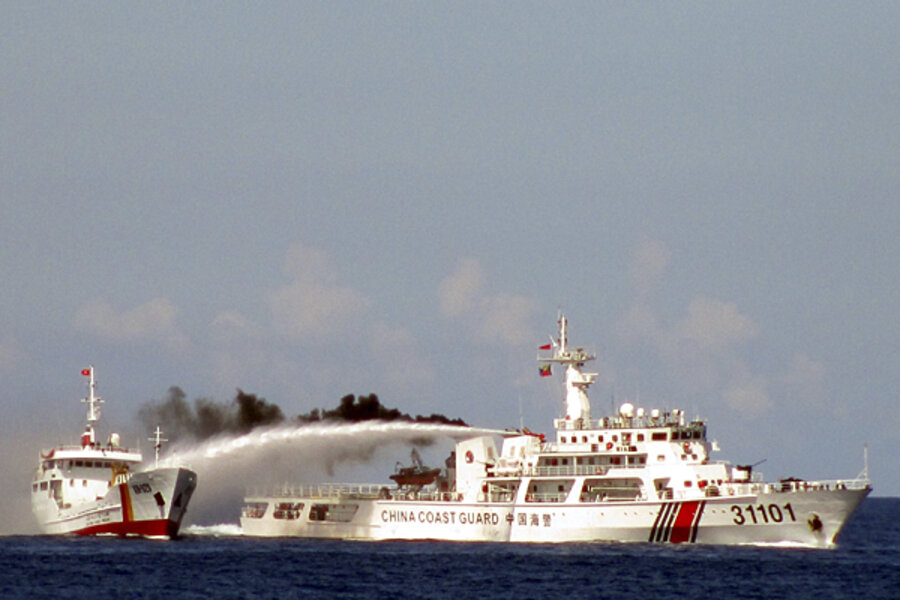China, Vietnam at odds over oil in South China Sea
Loading...
Vietnam and China are engaged in a heated standoff in the South China Sea, with both sides thus far unwilling to back down. The problem started earlier this week when China sent an oil rig and other accompanying vessels into an area within the 200-mile exclusive economic zone of Vietnam. From there, things took a turn for the worse.
Vietnamese officials reported that Chinese vessels rammed Vietnamese ships and fired water cannons on May 7, from which several sailors were injured. China also allegedly used low flying aircraft to intimidate Vietnam. The following day, Vietnam apparently returned the favor, according to officials in Beijing. China claims that Vietnam rammed Chinese ships 171 times since May 3.
China is “deeply shocked” (shocked!) at Vietnam’s “disruption” of what China sees as its perfectly legal drilling operation in the South China Sea.
“We cannot tolerate any behavior that would undermine the safety of our personnel or our rig or drilling operation,” said Yi XianLiang, Deputy Director General of Boundary and Ocean Affairs, said at a press briefing according to Bloomberg. “In the face of Vietnamese disruption, China had to increase its security forces at the scene.” (Related Article: Iran Tears Up Azadegan Contract With China)
The two sides are fighting over control of the Paracel Islands, but the problem is that China’s claim to territory in the South China Sea has no basis in international law. Under the UN Convention on the Law of the Sea (UNCLOS) countries can submit claims to territory up to 200 miles from their shores. China’s oil rig is sitting well within the 200 mile boundary of Vietnam’s EEZ.
But China’s “Nine Dashed Line” principle – which China uses to claim territory – draws its boundaries so deeply into neighboring countries’ waters, hundreds of miles from the Chinese mainland. The fight centers around the Paracel Islands, which China occupies and claims are islands. Neighboring countries insist they are just rocks, not islands, and thus cannot be used to justify the extension of territorial claims 200 miles outwards under UNCLOS.
The Philippines is formally seeking international arbitration on the legality of China’s “Nine Dashed Line,” hoping to get China’s claims thrown out.
China is dismissing such complaints and decided to unilaterally move in to Vietnamese waters to drill for oil. The EIA estimates that the South China Sea holds 11 billion barrels of oil and 190 trillion cubic feet of natural gas, but precise figures are unknown. China believes the totals could be several times as big. This is why the conflict over control of the South China Sea has become such a hot issue.
At the same time, China blames the U.S. for emboldening Southeast Asian nations to confront China. President Obama’s recent trip to the region was largely meant to reassure allies of America’s backing in the face of Chinese encroachment. (Related Article: How to Profit from Chinese LNG Demand)
The U.S. expressed concern over the latest incident. “We oppose any act intimidation by vessels, particularly in disputed areas,” said Daniel R. Russel, the Assistant Secretary of State for East Asian and Pacific Affairs. “Competing sovereignty claims in disputed areas, including the Paracels, must be dealt with peacefully, must be dealt with diplomatically and must be dealt with in accordance to international laws,” he said.
International arbitration may yet deliver a defeat to China, but the U.S. undermines its own credibility by being one of the few holdouts on the UN Convention on the Law of the Sea. Despite President Ronald Reagan helping to shape the final document, the U.S. did not sign UNCLOS, owing to a bizarre notion on behalf of some Republicans that doing so will mean submitting the U.S. to a world tax, global redistribution of wealth, and a supranational government.
So it is a bit ironic that the State Department urges the conflict be dealt with “in accordance with international law.” Without having ratified UNCLOS, the strongest statement from the U.S. can merely be to “urge restraint” on all sides.
Source: http://oilprice.com/Energy/Energy-General/U.S.-on-Sidelines-in-South-China-Sea-Standoff.html







